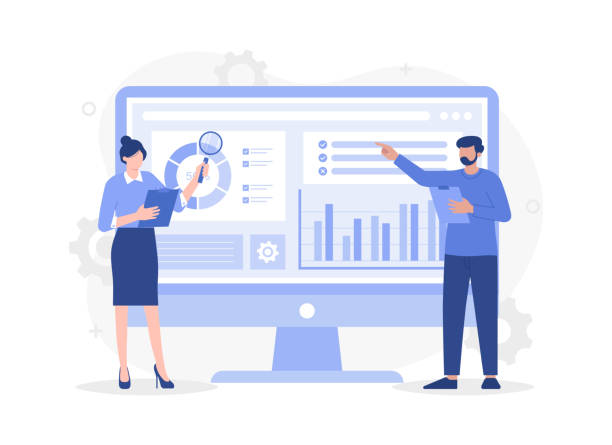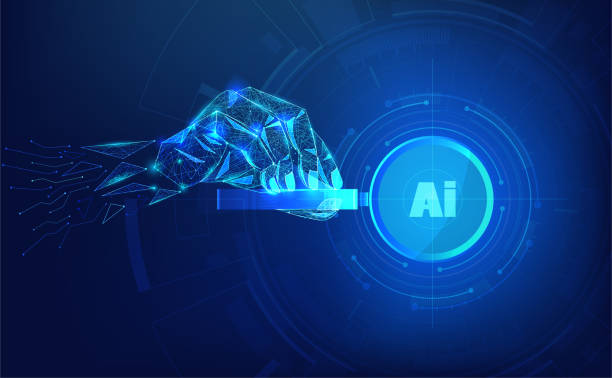The Unparalleled Importance of Modern UI Website Design in Today’s World

In the current digital age, where online competition has peaked, modern UI website design is no longer a luxury option, but an undeniable necessity for any business.
An #efficient_and_attractive_user_interface not only helps improve #user_experience, but also plays a significant role in #increasing_user_engagement and ultimately #business_success.
Today’s users have very high expectations from websites; they seek speed, ease of use, visual appeal, and a seamless experience across all devices.
If a website fails to meet these expectations, it will quickly lose its users, which means losing business opportunities and diminishing brand credibility.
This importance becomes even more evident when we consider that the first impression of a business is often formed through its website.
This modern approach to web design goes beyond mere aesthetics; it means deeply understanding user needs and behaviors, and then implementing solutions that best meet these needs.
Imagine entering a website that is visually appealing, but finding the information you need is difficult or slow.
Such an experience quickly leads to dissatisfaction and site abandonment.
In contrast, a website with modern UI website design easily guides users, presents information in an organized and accessible manner, and creates a sense of satisfaction and trust in them.
This means creating an enjoyable user experience (UX) that not only keeps the user on the site but also encourages them to return and engage further.
The goal is not just to attract users, but to retain them and convert visitors into loyal customers.
Modern UI, by focusing on simplicity, clarity, and effectiveness, achieves this.
This includes using intuitive navigation, engaging interactive elements, readable fonts, appropriate white space, and a harmonious color palette.
The ultimate goal is to reduce friction in the user’s journey and increase their enjoyment of interacting with the website.
This is a strategic investment that directly impacts conversion rates, user dwell time on the site, and ultimately, business profitability.
Furthermore, with the increasing emergence of various devices, including smartphones, tablets, and even smartwatches, responsive design has become one of the main pillars of modern UI website design.
A website that cannot adapt to different screen dimensions will quickly become obsolete and unusable.
This not only negatively affects user experience but can also lower the website’s ranking in search engines, as search engines prioritize responsive and mobile-friendly websites.
Investing in modern web development means investing in the future of the business and ensuring its strong presence in the online space.
This approach is the foundation of any successful digital marketing strategy, and without it, even the best content and strongest advertising campaigns cannot achieve their goals.
Tired of your e-commerce website not generating as much revenue as it could? Rasaweb, specializing in professional e-commerce website design, solves this problem permanently!
✅ Increase sales rate and revenue
✅ High load speed and unparalleled user experience
⚡ Get free consultation for e-commerce website design
Key Principles of Modern UI Design for Websites

When we talk about modern UI website design, a set of underlying principles and rules emerge that are essential for achieving an outstanding user experience.
These principles go beyond mere visual aesthetics and address the efficiency, usability, and accessibility of the website.
This comprehensive approach guarantees the long-term success of a web project.
One of the most important of these principles is responsive design.
In today’s world with countless devices, from small mobiles to wide monitors, the website must be able to adapt its appearance and functionality to the screen size and type to provide a consistent and optimal experience.
Ignoring this principle means losing a significant portion of the audience who use different devices and can lead to a high Bounce Rate.
The second principle is minimalism and simplicity.
Modern design emphasizes the removal of unnecessary elements and visual clutter.
The goal is for the user to be able to achieve their objective on the site without any distraction.
This approach means using ample white space, clear visual hierarchy, and a limited number of colors and fonts.
Every element on the page must be purposeful and help the user achieve their goal.
Simplicity leads to faster understanding and easier interaction, eliminating unnecessary complexities.
Visual and intuitive navigation is another critical principle in modern web design.
Users should be able to understand how to navigate the site and access the information they need without thinking.
Menus should be clear, consistent, and logical.
Using standard icons and clear labels can help with this.
The less a user has to search for their way, the better their experience will be.
A good navigation system keeps users on the site and directs them toward your business goals.
High loading speed is also a fundamental factor.
Modern users have little patience, and any delay in page loading can lead to site abandonment.
Research has shown that even a few seconds of delay can drastically reduce conversion rates.
Optimizing images, using clean and efficient code, and utilizing a CDN (Content Delivery Network) are among the measures that help improve speed.
Speed not only affects user experience but is also an important factor in search engine ranking.
Finally, Accessibility is of paramount importance.
A website with modern UI website design should be usable for all users, regardless of their abilities (e.g., visually impaired, hearing impaired, etc.).
This includes using alternative texts for images, appropriate color contrast, and keyboard navigation capability.
Adhering to these principles is not only ethical and contributes to a more inclusive society but also encompasses a wider target market.
These are just some of the foundations upon which web UI optimization is built.
Leading Tools and Technologies in Modern Web UI Design
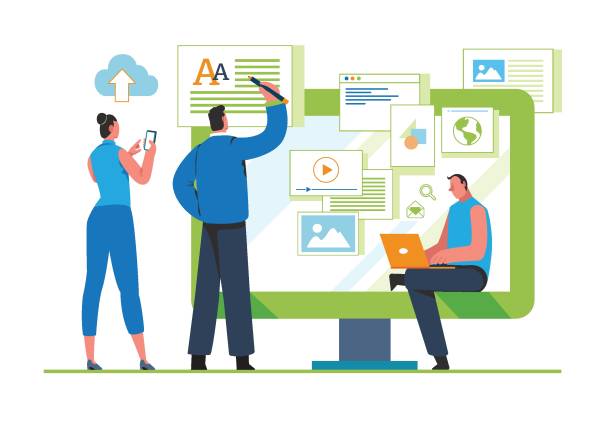
The field of modern UI website design is constantly evolving, with new tools and technologies being released to simplify and improve the design and development process.
Choosing the right tools can significantly impact the efficiency, creativity, and speed of the design team.
In the past, designers primarily used software like Photoshop for UI design, but today, more specialized tools with unique capabilities are available that have revolutionized the process of building websites with advanced user experience.
These tools enable team collaboration, rapid prototyping, and easier user testing.
One of the most popular UI/UX design tools currently is Adobe XD.
This software allows designers to quickly and easily create wireframes, prototypes, and user interfaces (UI).
Real-time collaboration features and the ability to test on actual devices make it a powerful tool for design teams.
Figma is another giant in this field that has gained immense popularity due to its online collaborative capabilities and no-installation requirement.
This tool facilitates easy design, prototyping, and sharing, allowing teams to work simultaneously on a project.
Also, Sketch, which is more popular among macOS users, still holds a special place among professional designers with its rich plugins.
For developers, Frontend Frameworks play a vital role.
ReactJS, Angular, and Vue.js are among the most popular of these frameworks, which simplify the process of building complex and interactive user interfaces by providing reusable components and strong development structures.
These frameworks help developers create high-performance websites with smooth user experiences and have become a new standard for modern UI implementation.
Additionally, using Design Systems like Google’s Material Design or Ant Design significantly helps ensure consistency and uniformity in UI design.
These systems provide a set of guidelines, components, and design principles that enable teams to create websites with a consistent look and feel more quickly and accurately.
This approach is particularly useful for large projects and multi-person teams, as it helps standardize and reduces design time.
With the advancement of artificial intelligence, new tools are also emerging that help designers automate repetitive tasks, generate initial designs, and even analyze user data.
These advancements have made the path of modern UI website design more exciting and efficient than ever.
These tools are only a small part of a vast ecosystem that helps designers and developers deliver the best results in the field of modern UI implementation.
Table 1: Comparison of UI/UX Design Tools
| Tool | Key Features | Suitable for | Notable Feature |
|---|---|---|---|
| Adobe XD | Wireframe, Prototype, UI design, Team collaboration | UI/UX designers, Product teams | Integration with Adobe ecosystem, High speed |
| Figma | UI/UX design, Prototyping, Online team collaboration | Large teams, Collaborative projects, Startups | Real-time collaboration, Browser-based access |
| Sketch | UI and icon design, Diverse plugins | Product designers, Frontend developers | Large user community, Powerful plugins |
| Axure RP | Complex prototyping, Dynamic wireframing | UX designers, Business analysts | Advanced prototyping and interaction capabilities |
The Difference and Synergy of UX and UI in Modern Web Design
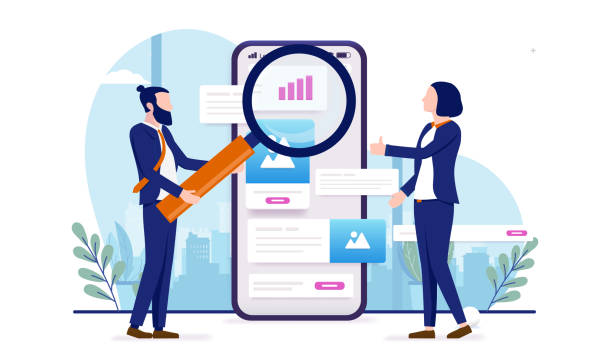
In the discussion of modern UI website design, two key concepts, UI (User Interface) and UX (User Experience), are always brought up and often confused with each other, but in reality, they are complementary.
Understanding their differences and synergy is essential for achieving a successful website.
#UX stands for #User_Experience and encompasses all the feelings, attitudes, and perceptions of a user when interacting with a product or system.
UX is deeper than a website’s appearance and addresses how easily and enjoyably a user can achieve their goals on the site.
This includes user research, competitor analysis, user journey design, information architecture, and usability testing.
A good user experience solves user problems and guides them in the right direction, even if it is not visually outstanding.
In contrast, #UI stands for #User_Interface and refers to the visual and interactive part of a website.
UI is what the user sees and interacts with: buttons, icons, images, fonts, colors, and all the visual elements that make up a website.
The UI designer’s task is to make the site’s appearance attractive, visual, and understandable so that the user can easily connect with it and enjoy using it.
Good UI enhances the beauty and accessibility of the product, making it more pleasant for the user.
To put it simply, if we consider a website as a car, UX is like the overall driving experience: Is it comfortable to drive? Are the seat ergonomics and controls suitable? Is the engine efficient? While UI is like the dashboard, seats, steering wheel, and car color; meaning all the visual and tangible elements you directly interact with.
A car can be visually (UI) very beautiful, but if driving it (UX) is difficult or unpleasant, no one will want to use it.
Similarly, a website can have excellent UX (the user easily achieves their goal), but if its UI is not attractive, it may not initially attract users.
To build a website with an advanced user experience, both UX and UI must work simultaneously and in harmony.
A UX designer first identifies user needs and creates a logical structure for the site that addresses these needs.
Then, the UI designer covers this structure with attractive and user-friendly visual elements to make its use enjoyable and intuitive.
This synergy ensures that the website not only looks beautiful and modern but is also enjoyable and efficient to use.
Ultimately, modern UI website design reaches its peak when these two disciplines work inseparably together to provide a complete and flawless digital experience.
Ignoring either of these two concepts means leaving the project incomplete and failing to achieve its full potential, and can lead to user loss and reduced profitability.
Are you tired of your e-commerce site having visitors but no sales? Rasaweb solves your main problem with professional e-commerce website design!
✅ Significant increase in sales with targeted design
✅ Flawless user experience for your customers
⚡ Get a free consultation now!
Current and Future Trends in Web UI Design
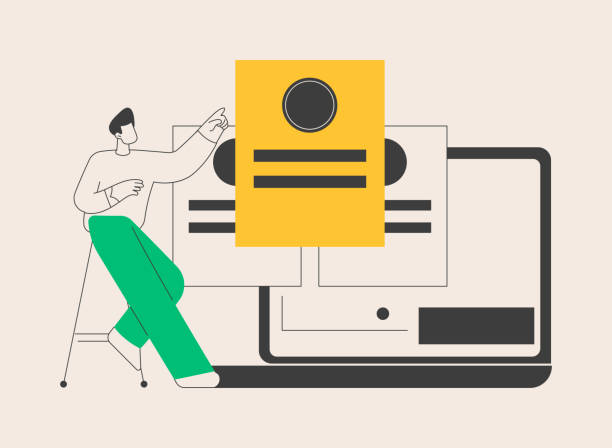
The world of modern UI website design is constantly evolving, and every year we witness the emergence of new trends that improve user experience.
Awareness of these trends is crucial for designers and businesses to keep their websites fresh, attractive, and efficient.
These changes reflect technological advancements and shifts in user expectations.
One of the most important current trends is the use of subtle animations and micro-interactions.
These animations not only bring a website to life but can also provide visual feedback to the user (e.g., when a button is clicked) and help improve navigation.
They increase the sense of interaction and enjoyment, enriching the user experience without causing distraction or slowness.
Dark Mode has also become extremely popular.
Given that many users spend long hours in front of screens, offering an option to switch to dark mode can help reduce eye strain and provide a more comfortable experience, especially in low-light environments.
This feature is not only visually appealing but also a functional advantage, indicating the designer’s attention to user comfort.
This trend is rapidly becoming widespread across various applications and websites.
Bold and custom typography is another important trend.
Using large, bold, and unique fonts can create a stronger visual identity for the brand and make content more engaging and readable.
This approach allows designers to convey messages with more creativity and prevent websites from looking repetitive.
Typography alone can act as a powerful graphic element and have a significant visual impact.
With the increasing importance of environmental protection, Sustainable Web Design is also gaining traction.
This approach focuses on building websites with less energy consumption, more optimized code, and more efficient server resource utilization.
This is not only beneficial for the environment but can also help improve loading speed and reduce operational costs, which has economic benefits for both users and businesses.
In the future, we can expect Virtual Reality (VR) and Augmented Reality (AR) experiences to be more integrated into websites, especially in areas such as e-commerce, education, and entertainment.
Also, Voice User Interfaces (Voice UI) and the use of artificial intelligence for personalizing user experience will become dominant trends.
These technologies have the potential to completely transform how we interact with the web and blur the lines between the physical and digital worlds.
Therefore, for anyone working in modern web development, it is essential to constantly seek to learn and adapt to these changes to be able to deliver websites with truly modern and cutting-edge user interfaces and remain competitive in the market.
The Impact of Modern UI Website Design on Business Success
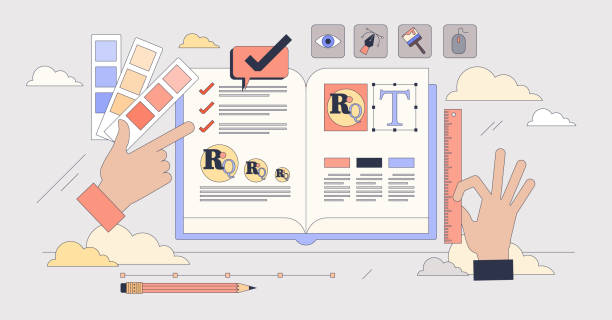
In today’s e-commerce and digital world, modern UI website design is no longer just an aesthetic element, but a vital and direct factor in the success and growth of businesses.
Investing in an optimized and modern user interface yields significant returns in the form of increased conversion rates, improved SEO, strengthened brand, and customer loyalty.
Ignoring this aspect can mean losing a competitive advantage and ultimately falling behind competitors.
The first noticeable impact is an increase in Conversion Rate.
A website with an attractive, easy-to-use, and logical user interface encourages users to perform desired business actions, such as purchasing a product, completing a form, or subscribing to a newsletter.
Any friction in the process, from difficult navigation to long and complex forms, can cause users to abandon the site before reaching their goal.
A modern UI makes these processes smooth and enjoyable, paving the way for the user to reach their objective.
The second impact is improved search engine ranking (SEO).
Search engines like Google place great importance on user experience factors (such as loading speed, responsiveness, and low bounce rate).
Websites that offer a better user experience and where users spend more time generally rank higher in search results.
Therefore, building a website with an advanced user experience indirectly helps increase the site’s visibility and organic traffic, which in turn leads to increased potential for customer acquisition.
Furthermore, a modern user interface helps to strengthen brand identity and increase trust.
A website that looks professional, modern, and cohesive reinforces the brand’s credibility and trustworthiness in users’ minds.
This is especially critical for new businesses or those looking to differentiate themselves in competitive markets.
Users are more likely to trust a brand that has paid attention to detail and refinement in its website, which demonstrates respect for the customer.
Finally, increased customer loyalty and user retention are among the other benefits of modern UI website design.
If users have a positive and hassle-free experience on your website, they are more likely to return and even recommend it to others.
This positive cycle leads to sustainable business growth and, in the long run, also reduces marketing costs.
In fact, any business seeking sustainability and growth in the online space should prioritize modern UI implementation; because it is an investment that, in the long run, guarantees its profitability and success.
Challenges and Solutions in Modern UI Website Design
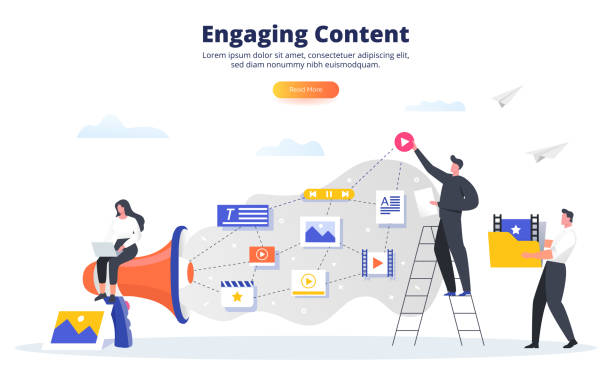
Despite all the countless benefits of modern UI website design, this process, like any other specialized field, comes with challenges that designers and developers must address.
Identifying these challenges and finding appropriate solutions to overcome them is key to achieving a successful and user-friendly website and requires a comprehensive and iterative approach.
One of the biggest challenges is maintaining simplicity while offering rich functionality.
Today’s users expect websites to be both beautiful and functionally powerful and feature-rich.
Creating a balance between these two aspects can be difficult.
The solution is that every feature and element must be carefully examined to ensure it adds to the user experience and does not cause unnecessary complexity.
The philosophy of minimalism is very applicable here: keep only the elements that add real value to the user and remove the rest.
Another challenge is compatibility with different browsers and devices.
Ensuring that the website is displayed correctly and functions properly across all browsers (Chrome, Firefox, Safari, etc.) and devices (mobile, tablet, desktop with different resolutions) requires continuous and thorough testing.
This challenge is constantly becoming more complex due to the increasing diversity of devices and browser versions.
Using responsive frameworks (like Bootstrap or Tailwind CSS) and automated testing tools (like BrowserStack) can be helpful in this regard.
Managing user expectations and gathering feedback is also of high importance.
User expectations are constantly changing, and what is considered modern today may be obsolete tomorrow.
Designers need to regularly gather user feedback through surveys, A/B tests, and behavioral analytics (like heatmaps and session recordings) and update designs accordingly.
This iterative approach in modern web UI design is vital for the website to remain relevant and engaging.
Performance and loading speed issues are also common challenges.
Visually rich designs with many images and animations can slow down loading, which severely degrades the user experience.
Optimizing images (compression, using next-gen formats like WebP), compressing code (CSS, JavaScript), using SVG for vector graphics, and implementing Lazy Loading for content are effective solutions in this area.
Also, using Content Delivery Networks (CDNs) can significantly increase access speed for users from different parts of the world.
Finally, maintaining security and user privacy is a fundamental challenge in every modern web development approach.
Designers and developers must ensure that websites are not only beautiful and efficient but also adequately protect user data.
Using HTTPS, data encryption, adhering to web security standards, and privacy regulations (like GDPR) are essential requirements.
Overcoming these challenges requires technical knowledge, creativity, and commitment to best design practices, which ultimately leads to modern and successful UI website design and builds user trust.
Table 2: Common Challenges in Modern UI Design and Their Solutions
| Challenge | Description | Suggested Solution |
|---|---|---|
| Over-complexity | Adding too many unfiltered features confuses the user and reduces efficiency. | Adherence to the principle of minimalism, prioritizing features, using Progressive Disclosure. |
| Lack of responsiveness | Incorrect display of the website on different devices and screen sizes. | Using responsive frameworks (like Bootstrap), Mobile-first design, testing on multiple devices and simulators. |
| Slow loading speed | Large image and code sizes cause the site to slow down and drive users away. | Image optimization (compression, modern formats), code compression, using CDN, Lazy Loading for content. |
| Accessibility violation | Lack of usability for users with special needs (e.g., blind or physically impaired). | Adherence to WCAG standards, using alt text for images, appropriate color contrast, keyboard navigation. |
| Lack of visual consistency | Inconsistency in fonts, colors, and element styles throughout the website. | Creating and adhering to a comprehensive design system, using style guides and component libraries. |
Case Study: Successful Examples in Modern Web UI Design
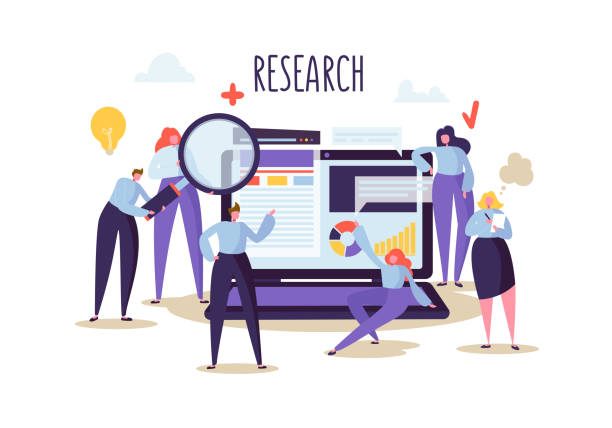
To gain a deeper understanding of how to successfully implement modern UI website design, examining prominent and popular examples can be highly inspiring.
These websites are not only visually appealing but also provide a flawless user experience and can serve as models for web UI optimization and achieving business goals.
This case study shows us how leading companies have managed to establish their position in the market by investing in design.
One prominent example is the Apple website.
Apple has always been known for its minimalist and user-friendly designs.
Their website utilizes abundant white space, high-quality images, readable fonts, and extremely simple and intuitive navigation.
Each page is designed to showcase the product or service in the best possible way and guide the user towards key information or purchase.
Clever use of animations and parallax scrolling makes the product viewing experience more engaging and conveys the brand’s luxurious feel.
This design is not only beautiful but also highly functional and focused on product sales.
Another example is Airbnb.
This accommodation rental platform has attracted millions of users with its very clean and easy-to-use user interface.
Its outstanding features include powerful and visual search filters, large and high-quality images of accommodations, and a simple and transparent booking process that allows the user to quickly and effortlessly find and book their desired accommodation.
Airbnb demonstrates how modern UI website design can efficiently and simply provide a complex service to users and gain their trust.
Stripe, an online payment platform, is an excellent example of a modern and highly technical website UI that has managed to present the complexities of its service in a simple and understandable way to developers and businesses.
Their website, with its focus on clear documentation, understandable code examples, and a clean visual design, builds user trust.
This shows that even for specialized and complex products, a modern and efficient user interface can make a difference and attract technical users.
These examples show that the key to success in building a website with an advanced user experience lies in a deep understanding of the audience, simplicity in design, and attention to detail.
Each of these companies, by focusing on the ultimate user experience, has been able to establish its position in the market and achieve significant growth.
These case studies emphasize that modern UI website design is a strategic investment that directly impacts business performance and significantly helps not only attract but also retain and build customer loyalty.
Does your current website showcase your brand’s credibility as it should? Or does it drive away potential customers?
Rasaweb, with years of experience in professional corporate website design, is your comprehensive solution.
✅ A modern, beautiful website tailored to your brand identity
✅ Significant increase in lead generation and new customer acquisition
⚡ Contact Rasaweb now for a free corporate website design consultation!
The Future of Web UI Design: AI, VR, and Beyond

The future of modern UI website design is changing at an astonishing pace, and technological advancements like Artificial Intelligence (AI), Virtual Reality (VR), and Augmented Reality (AR) will play a pivotal role in shaping this future.
These technologies have the potential to completely transform the human interaction experience with websites and push the current boundaries of UI design.
Understanding this evolutionary path is essential for designers and developers to prepare themselves for the challenges and opportunities ahead.
Artificial Intelligence (AI) is already permeating the design process.
AI-powered tools can help designers automate repetitive tasks, analyze user data to identify patterns, and even generate initial designs.
In the future, AI could allow websites to dynamically personalize the user interface based on each user’s behavior and preferences.
This means an infinitely customized and optimized user experience that has never before been possible.
Imagine a website that automatically adjusts its layout, colors, and content to match your unique needs! This deep personalization can lead to a dramatic increase in user engagement and satisfaction.
Virtual Reality (VR) and Augmented Reality (AR) also open new horizons for building websites with advanced user experience.
Currently, these technologies are mostly seen in games and specialized applications, but they will gradually make their way into the web as well.
For example, in e-commerce, users can use AR to try products in their real space (e.g., viewing furniture in their home) or enter virtual 3D stores with VR.
This level of immersion and interaction will completely revolutionize the online shopping experience and blur the lines between online and physical shopping.
For instance, a travel website could allow you to virtually view hotel rooms with VR before booking.
Voice User Interfaces (Voice UI) are also growing significantly.
With the widespread use of voice assistants like Siri, Alexa, and Google Assistant, it is expected that voice interaction with websites will become more common.
Designers should think about designing interfaces that can be controlled by both touch and voice.
This is especially important for accessibility and users with physical limitations.
This shift towards multimodal interactions adds new layers of complexity and creativity to modern web UI design.
These developments indicate that modern UI website design will become increasingly personalized, immersive, and intelligent in the future.
Successful designers will be those who can understand and integrate these emerging technologies into their work and create websites that respond not only to current needs but also to future user expectations.
This is an exciting period for the field of modern UI website design, offering countless opportunities for innovation and completely changing the web landscape.
Step-by-Step Guide to Modern UI Website Design
![]()
For any business or individual looking to create or redesign a website, understanding the process of modern UI website design is crucial.
This is a systematic process that involves multiple stages from research to implementation and testing.
Following these steps not only helps you have a beautiful and user-friendly website but also saves time and money.
Here is a step-by-step guide for this process.
1.
User Research: This is the first and most vital step.
You need to thoroughly understand your target audience.
Who are they? What are their needs? How do they interact with websites? What are their pain points? Tools such as Persona, User Journey Map, and user interviews can be very useful at this stage.
Without a deep understanding of the user, any web UI optimization will be useless and may lead to designing a product that no one needs.
2.
Analysis & Planning: After collecting information, it’s time to analyze it.
The overall website structure (information architecture), sitemap, and user flow are designed at this stage.
This step helps you get an overview of the content and how pages connect with each other, ensuring that all information is logically organized and accessible.
This roadmap provides the foundation for visual design and development.
3.
Wireframing & Prototyping: In this stage, initial, raw designs (wireframes) of website pages are created.
Wireframes help display element layouts and information hierarchy, without getting bogged down in visual details.
Then, more interactive prototypes are built, allowing you to simulate the user flow and get feedback before actual coding.
These steps are very important in building a website with an advanced user experience because they allow for identifying and fixing problems in the early stages, which is much cheaper than fixing them after coding.
4.
Visual Design (UI Design): Now it’s time to design the website’s appearance.
Choosing colors, fonts, icons, images, and animations is done at this stage.
The UI designer focuses on details that make the website look attractive and modern, while also adhering to UX principles.
Using a Design System at this stage can help maintain visual consistency and harmony of elements throughout the website and accelerate the process.
5.
Implementation & Development: After the designs are finalized, frontend and backend developers code the website using relevant programming languages and frameworks.
Ensuring the website’s responsiveness, high speed, and security is crucial at this stage.
This step involves transforming visual designs into executable code that brings the website to life.
6.
Testing & Optimization: The website must be thoroughly tested to ensure correct functionality across different devices and browsers.
Usability Testing with real users is essential to identify weaknesses and improve them.
This stage is iterative and should be performed continuously even after launch so that modern UI website design always remains up-to-date and efficient.
By following these steps, you can ensure that your website is not only beautiful but also provides an unparalleled experience for users and helps achieve your business goals.
Frequently Asked Questions
| Row | Question | Answer |
|---|---|---|
| 1 | What does Modern UI in website design mean? | Modern UI means designing websites with a minimalist appearance, extensive use of white space, clear typography, vibrant colors or harmonious palettes, subtle animations, and a focus on visual and intuitive user experience (UX). |
| 2 | What features make a user interface “modern”? | Key features include responsive design, smooth animations, use of vectors and SVG icons, prominent typography, sufficient white space, creative layering, harmonious colors, and a focus on accessibility. |
| 3 | What is the importance of Responsive Design in modern UI? | Responsive design ensures that the website displays correctly on any device (mobile, tablet, desktop) and provides a consistent user experience, which is a fundamental principle of modern UI. |
| 4 | Why is the use of White Space important in modern design? | White space or “negative space” helps text and other elements breathe and be distinguishable, increases readability, enhances user focus on the main content, and creates a clean and professional look. |
| 5 | What is the role of animations and micro-interactions in modern UI? | Animations and micro-interactions (small interactions) make the user experience more dynamic and engaging, provide feedback to the user, improve navigation flow, and impart a sense of quality and polish to the design. |
| 6 | What is the place of typography in modern website design? | Typography plays a very important role in modern design; appropriate fonts, size, weight, and correct spacing improve readability and can give a specific feel and personality to the brand. |
| 7 | How can visual consistency be achieved in modern design? | By using a design system, a limited and defined color palette, consistent typography, reusable UI components, and maintaining uniformity in spacing between elements and visual rhythm. |
| 8 | What is the relationship between User Experience (UX) and modern User Interface (UI)? | User Interface (UI) is the visual and interactive part of a product, while User Experience (UX) relates to the user’s overall feeling when using the product. A modern UI should help improve UX and be functional and intuitive beyond visual appeal. |
| 9 | What are some common trends in modern UI design? | Trends include Dark Mode, Neumorphism, Glassmorphism, large and prominent typography, use of gradients, 3D images, and Lottie animations. |
| 10 | What are the main challenges in modern UI website design? | Challenges include maintaining simplicity while innovating, ensuring accessibility, optimizing loading speed despite heavy animations and images, and maintaining a balance between aesthetics and functionality. |
And other services of Rasaweb Advertising Agency in the field of advertising:
Smart Customer Journey Map: Professional optimization to increase click-through rates using Google Ads management.
Smart Data Analysis: An effective tool for customer acquisition through marketing automation.
Smart Advertorials: A specialized service for increasing user engagement based on real data.
Smart Conversion Rate Optimization: A combination of creativity and technology to increase site traffic through attractive UI design.
Smart Conversion Rate Optimization: A specialized service for increasing site traffic growth based on custom programming.
And over hundreds of other services in the field of internet advertising, advertising consulting, and organizational solutions.
Internet Advertising | Advertising Strategy | Advertorial
Resources
Web Design Trends in 2023UI/UX Design PrinciplesThe Future of Web DevelopmentModern Web Technologies
🌐 Rasaweb Afarin Digital Marketing Agency specializes in providing comprehensive digital solutions for your business. From SEO strategies and content marketing to advanced e-commerce website design and targeted advertising campaigns, we transform your online presence.
📍 Tehran, Mirdamad Street, Next to Central Bank, Southern Kazeroun Alley, Ramin Alley, No. 6

